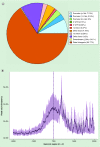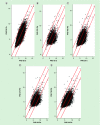Histone acetylation maps in aged mice developmentally exposed to lead: epigenetic drift and Alzheimer-related genes
- PMID: 29722544
- PMCID: PMC5992572
- DOI: 10.2217/epi-2017-0143
Histone acetylation maps in aged mice developmentally exposed to lead: epigenetic drift and Alzheimer-related genes
Abstract
Aim: Early life exposure to lead (Pb) has been shown to increase late life biomarkers involved in Alzheimer's disease (AD) pathology. Here, we tested the hypothesis that latent over expression of AD-related genes may be regulated through histone activation pathways.
Methods: Chromatin immunoprecipitation sequencing was used to map the histone activation mark (H3K9Ac) to the mouse genome in developmentally Pb exposed mice on postnatal days 20, 270 and 700.
Results: Exposure to Pb resulted in a global downregulation of H3K9Ac across the lifespan; except in genes associated with the Alzheimer pathway.
Discussion: Early life exposure to Pb results in an epigenetic drift in H3K9Ac consistent with latent global gene repression. Alzheimer-related genes do not follow this trend.
Keywords: Alzheimer's disease; epigenetics; histone acetylation; lead (Pb).
Conflict of interest statement
This research was supported by the Intramural Research Program of the NIH, National Institute of Environmental Health Sciences, and by grant 5RO1ES015867-03. This research is based in part upon work conducted using the Rhode Island IDeA Network for Excellence in Biomedical Research Bioinformatics Core which is supported by the NIH under grant 2P20GM103430. JM Gaspar and RP Hart were supported by NIH grants 1R01AT009152 to A-N Kong of Rutgers University and 1R01ES026057 and R21DA035594 to RP Hart. The authors have no other relevant affiliations or financial involvement with any organization or entity with a financial interest in or financial conflict with the subject matter or materials discussed in the manuscript apart from those disclosed.
No writing assistance was utilized in the production of this manuscript.
Figures





Similar articles
-
Alzheimer's disease biomarkers and epigenetic intermediates following exposure to Pb in vitro.Curr Alzheimer Res. 2012 Jun;9(5):555-62. doi: 10.2174/156720512800617964. Curr Alzheimer Res. 2012. PMID: 22272629
-
Early life exposure to lead (Pb) and changes in DNA methylation: relevance to Alzheimer's disease.Rev Environ Health. 2019 Jun 26;34(2):187-195. doi: 10.1515/reveh-2018-0076. Rev Environ Health. 2019. PMID: 30710487 Review.
-
Early-life Pb exposure as a potential risk factor for Alzheimer's disease: are there hazards for the Mexican population?J Biol Inorg Chem. 2019 Dec;24(8):1285-1303. doi: 10.1007/s00775-019-01739-1. Epub 2019 Nov 26. J Biol Inorg Chem. 2019. PMID: 31773268 Review.
-
Infant exposure to lead (Pb) and epigenetic modifications in the aging primate brain: implications for Alzheimer's disease.J Alzheimers Dis. 2011;27(4):819-33. doi: 10.3233/JAD-2011-111013. J Alzheimers Dis. 2011. PMID: 21891863
-
Epigenetic histone modification regulates developmental lead exposure induced hyperactivity in rats.Toxicol Lett. 2014 Feb 10;225(1):78-85. doi: 10.1016/j.toxlet.2013.11.025. Epub 2013 Dec 1. Toxicol Lett. 2014. PMID: 24291742
Cited by
-
Direct Conversion of Fibroblast into Neurons for Alzheimer's Disease Research: A Systematic Review.J Alzheimers Dis. 2023;95(3):805-828. doi: 10.3233/JAD-230119. J Alzheimers Dis. 2023. PMID: 37661882 Free PMC article.
-
Associations of Environmental Exposure to Arsenic, Manganese, Lead, and Cadmium with Alzheimer's Disease: A Review of Recent Evidence from Mechanistic Studies.J Xenobiot. 2025 Mar 24;15(2):47. doi: 10.3390/jox15020047. J Xenobiot. 2025. PMID: 40278152 Free PMC article. Review.
-
Epigenetic Basis of Lead-Induced Neurological Disorders.Int J Environ Res Public Health. 2020 Jul 7;17(13):4878. doi: 10.3390/ijerph17134878. Int J Environ Res Public Health. 2020. PMID: 32645824 Free PMC article. Review.
-
Alzheimer's Disorder: Epigenetic Connection and Associated Risk Factors.Curr Neuropharmacol. 2020;18(8):740-753. doi: 10.2174/1570159X18666200128125641. Curr Neuropharmacol. 2020. PMID: 31989902 Free PMC article. Review.
-
Epigenetic Modifications in Alzheimer's Neuropathology and Therapeutics.Front Neurosci. 2019 May 10;13:476. doi: 10.3389/fnins.2019.00476. eCollection 2019. Front Neurosci. 2019. PMID: 31133796 Free PMC article. Review.
References
-
- Portha B, Fournier A, Kioon MD, Mezger V, Movassat J. Early environmental factors, alteration of epigenetic marks and metabolic disease susceptibility. Biochimie. 2014;97:1–15. - PubMed
-
- Tanner CM, Goldman SM, Ross GW, Grate SJ. The disease intersection of susceptibility and exposure: chemical exposures and neurodegenerative disease risk. Alzheimers Dement. 2014;10(3 Suppl.):S213–S225. - PubMed
Publication types
MeSH terms
Substances
Grants and funding
LinkOut - more resources
Full Text Sources
Other Literature Sources
Medical
